高中语音课英文教案
- 格式:docx
- 大小:16.39 KB
- 文档页数:11
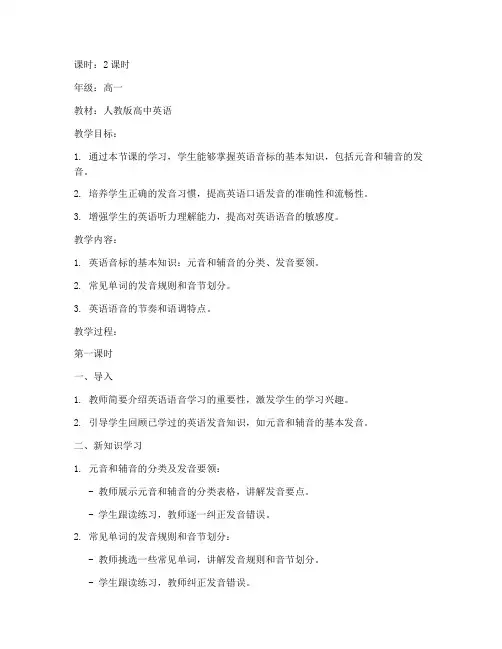
课时:2课时年级:高一教材:人教版高中英语教学目标:1. 通过本节课的学习,学生能够掌握英语音标的基本知识,包括元音和辅音的发音。
2. 培养学生正确的发音习惯,提高英语口语发音的准确性和流畅性。
3. 增强学生的英语听力理解能力,提高对英语语音的敏感度。
教学内容:1. 英语音标的基本知识:元音和辅音的分类、发音要领。
2. 常见单词的发音规则和音节划分。
3. 英语语音的节奏和语调特点。
教学过程:第一课时一、导入1. 教师简要介绍英语语音学习的重要性,激发学生的学习兴趣。
2. 引导学生回顾已学过的英语发音知识,如元音和辅音的基本发音。
二、新知识学习1. 元音和辅音的分类及发音要领:- 教师展示元音和辅音的分类表格,讲解发音要点。
- 学生跟读练习,教师逐一纠正发音错误。
2. 常见单词的发音规则和音节划分:- 教师挑选一些常见单词,讲解发音规则和音节划分。
- 学生跟读练习,教师纠正发音错误。
三、课堂活动1. 分组练习:学生分成小组,互相纠正发音错误,提高发音水平。
2. 发音比赛:每组选出一名代表进行发音比赛,评选最佳发音者。
四、总结1. 教师总结本节课所学内容,强调发音的重要性。
2. 布置课后作业,要求学生复习本节课所学内容。
第二课时一、复习1. 教师提问,检查学生对上节课所学内容的掌握情况。
2. 学生分组练习,互相纠正发音错误。
二、新知识学习1. 英语语音的节奏和语调特点:- 教师讲解英语语音的节奏和语调特点,分析其与汉语的异同。
- 学生跟读练习,教师纠正发音错误。
2. 常见句子的发音练习:- 教师挑选一些常见句子,讲解发音技巧。
- 学生跟读练习,教师纠正发音错误。
三、课堂活动1. 角色扮演:学生分组进行角色扮演,练习英语口语发音。
2. 发音比赛:每组选出一名代表进行发音比赛,评选最佳发音者。
四、总结1. 教师总结本节课所学内容,强调英语语音的重要性。
2. 布置课后作业,要求学生复习本节课所学内容,并练习英语口语。
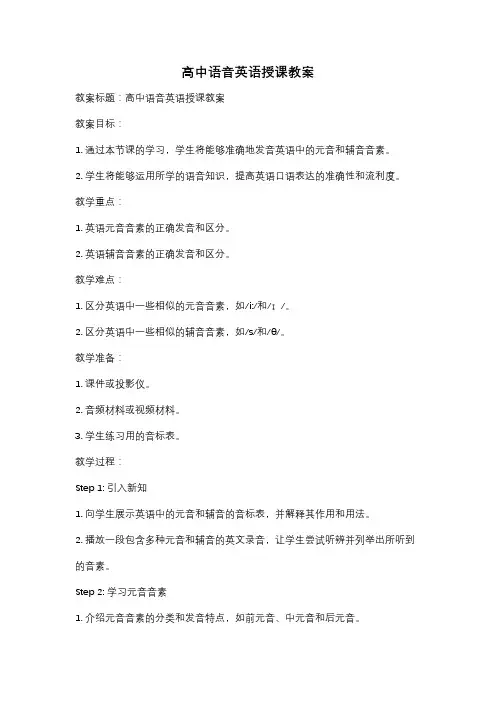
高中语音英语授课教案教案标题:高中语音英语授课教案教案目标:1. 通过本节课的学习,学生将能够准确地发音英语中的元音和辅音音素。
2. 学生将能够运用所学的语音知识,提高英语口语表达的准确性和流利度。
教学重点:1. 英语元音音素的正确发音和区分。
2. 英语辅音音素的正确发音和区分。
教学难点:1. 区分英语中一些相似的元音音素,如/i:/和/ɪ/。
2. 区分英语中一些相似的辅音音素,如/s/和/θ/。
教学准备:1. 课件或投影仪。
2. 音频材料或视频材料。
3. 学生练习用的音标表。
教学过程:Step 1: 引入新知1. 向学生展示英语中的元音和辅音的音标表,并解释其作用和用法。
2. 播放一段包含多种元音和辅音的英文录音,让学生尝试听辨并列举出所听到的音素。
Step 2: 学习元音音素1. 介绍元音音素的分类和发音特点,如前元音、中元音和后元音。
2. 播放包含不同元音音素的录音,让学生跟读并纠正发音错误。
3. 给学生分发练习材料,让他们进行元音音素的发音练习。
Step 3: 学习辅音音素1. 介绍辅音音素的分类和发音特点,如清辅音和浊辅音。
2. 播放包含不同辅音音素的录音,让学生跟读并纠正发音错误。
3. 给学生分发练习材料,让他们进行辅音音素的发音练习。
Step 4: 针对难点进行讲解和练习1. 分别解释/i:/和/ɪ/的发音特点,并进行示范和练习。
2. 分别解释/s/和/θ/的发音特点,并进行示范和练习。
Step 5: 综合练习1. 播放一段包含多种元音和辅音的英文录音,让学生尝试听辨并发音。
2. 给学生分发一篇短文,让他们阅读并标注出短文中的元音和辅音音素。
3. 学生之间进行口语练习,使用所学的语音知识进行对话。
Step 6: 总结和反馈1. 对本节课的内容进行总结,并强调学生在日常学习中的应用。
2. 鼓励学生反馈本节课的学习体会和困惑。
教学延伸:1. 学生可通过录音或视频自我评估自己的语音发音准确性,并进行改进。
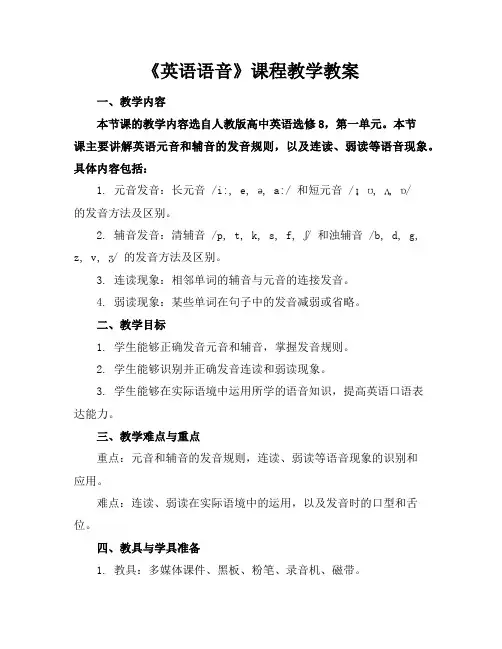
《英语语音》课程教学教案一、教学内容本节课的教学内容选自人教版高中英语选修8,第一单元。
本节课主要讲解英语元音和辅音的发音规则,以及连读、弱读等语音现象。
具体内容包括:1. 元音发音:长元音 /i:, e, ə, a:/ 和短元音 /ɪ, ʊ, ʌ, ɒ/的发音方法及区别。
2. 辅音发音:清辅音 /p, t, k, s, f, ʃ/ 和浊辅音 /b, d, g, z, v, ʒ/ 的发音方法及区别。
3. 连读现象:相邻单词的辅音与元音的连接发音。
4. 弱读现象:某些单词在句子中的发音减弱或省略。
二、教学目标1. 学生能够正确发音元音和辅音,掌握发音规则。
2. 学生能够识别并正确发音连读和弱读现象。
3. 学生能够在实际语境中运用所学的语音知识,提高英语口语表达能力。
三、教学难点与重点重点:元音和辅音的发音规则,连读、弱读等语音现象的识别和应用。
难点:连读、弱读在实际语境中的运用,以及发音时的口型和舌位。
四、教具与学具准备1. 教具:多媒体课件、黑板、粉笔、录音机、磁带。
2. 学具:课本、练习册、录音机、磁带。
五、教学过程1. 引入:通过播放一段英语对话,让学生注意到的语音现象,激发学生学习兴趣。
2. 讲解:讲解元音和辅音的发音规则,以及连读、弱读等语音现象,示例讲解,让学生跟着老师一起发音。
3. 练习:学生跟读课文,模仿发音,教师逐一纠正发音错误。
4. 应用:学生分组进行角色扮演,运用所学的语音知识进行对话,教师巡回指导。
六、板书设计1. 元音发音规则:长元音 /i:, e, ə, a:/短元音 /ɪ, ʊ, ʌ, ɒ/2. 辅音发音规则:清辅音 /p, t, k, s, f, ʃ/浊辅音 /b, d, g, z, v, ʒ/3. 连读现象:相邻单词的辅音与元音的连接发音。
4. 弱读现象:某些单词在句子中的发音减弱或省略。
七、作业设计1. 作业题目:(1) 模仿课本对话,注意连读、弱读的发音。
(2) 找出身边的英语语音例子,分析其发音规则。
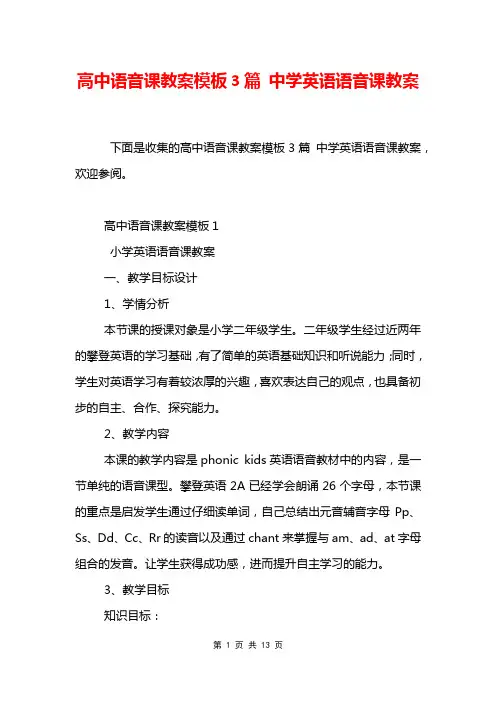
高中语音课教案模板3篇中学英语语音课教案下面是收集的高中语音课教案模板3篇中学英语语音课教案,欢迎参阅。
高中语音课教案模板1小学英语语音课教案一、教学目标设计1、学情分析本节课的授课对象是小学二年级学生。
二年级学生经过近两年的攀登英语的学习基础,有了简单的英语基础知识和听说能力;同时,学生对英语学习有着较浓厚的兴趣,喜欢表达自己的观点,也具备初步的自主、合作、探究能力。
2、教学内容本课的教学内容是phonic kids英语语音教材中的内容,是一节单纯的语音课型。
攀登英语2A已经学会朗诵26个字母,本节课的重点是启发学生通过仔细读单词,自己总结出元音辅音字母Pp、Ss、Dd、Cc、Rr的读音以及通过chant来掌握与am、ad、at字母组合的发音。
让学生获得成功感,进而提升自主学习的能力。
3、教学目标知识目标:能通过认读总结出p、s、d、c、r在单词中的读音,借助拼读方法fyn读出p、s、d、c、r与am、ad、at等组合成的单词:“Pig、pink、park、Pam、Sam、dog、duck、car、cat、rat”能力目标:(1)引导学生积极参加小组活动,促进他们养成动脑、动口和动手的好习惯,初步形成主动学习的意识。
(2)培养学生的分析能力。
情感目标:(1)借助chant的押韵和节奏感进一步提高学生对英语的学习热情及学习兴趣。
(2)鼓励学生积极主动参与课堂活动,大胆开口,主动模仿。
教学重点、难点:能够听懂,拼读,认读例词“Pig、pink、park、Pam、Sam、dog、duck、car、cat、rat”教具准备:课件二、教学过程设计Step1、Warming up1、Introduce and Greeting.(I am name is boys and to meet you.)2、We are studying English you chant“ ABC ”?出示字母表.Follow me please!Step2、Presentation1、导入:教师指向某个字母,示意学生举手回答:“what is this?”个别举手回答,答对的及时表扬。
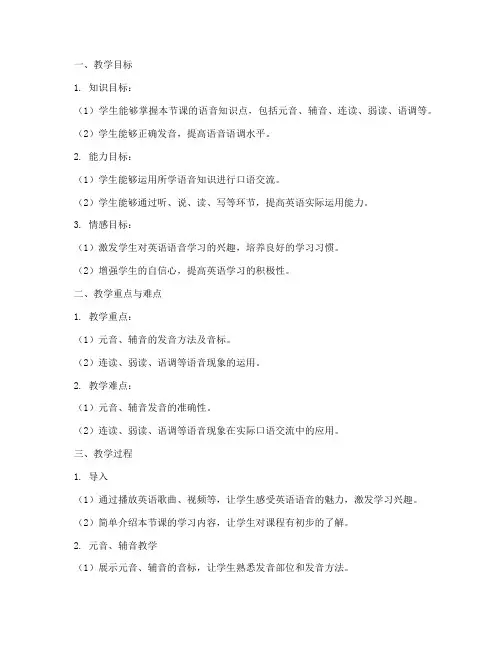
一、教学目标1. 知识目标:(1)学生能够掌握本节课的语音知识点,包括元音、辅音、连读、弱读、语调等。
(2)学生能够正确发音,提高语音语调水平。
2. 能力目标:(1)学生能够运用所学语音知识进行口语交流。
(2)学生能够通过听、说、读、写等环节,提高英语实际运用能力。
3. 情感目标:(1)激发学生对英语语音学习的兴趣,培养良好的学习习惯。
(2)增强学生的自信心,提高英语学习的积极性。
二、教学重点与难点1. 教学重点:(1)元音、辅音的发音方法及音标。
(2)连读、弱读、语调等语音现象的运用。
2. 教学难点:(1)元音、辅音发音的准确性。
(2)连读、弱读、语调等语音现象在实际口语交流中的应用。
三、教学过程1. 导入(1)通过播放英语歌曲、视频等,让学生感受英语语音的魅力,激发学习兴趣。
(2)简单介绍本节课的学习内容,让学生对课程有初步的了解。
2. 元音、辅音教学(1)展示元音、辅音的音标,让学生熟悉发音部位和发音方法。
(2)通过示范、跟读等方式,让学生掌握元音、辅音的发音技巧。
(3)进行听力练习,让学生辨别不同元音、辅音的发音。
3. 连读、弱读、语调教学(1)讲解连读、弱读、语调的概念和作用。
(2)通过示范、跟读等方式,让学生掌握连读、弱读、语调的运用方法。
(3)进行听力练习,让学生辨别不同语音现象在实际口语交流中的应用。
4. 综合练习(1)让学生进行口语练习,运用所学语音知识进行对话。
(2)组织小组活动,让学生在合作中提高语音水平。
(3)进行听写练习,巩固所学语音知识。
5. 总结与反思(1)教师总结本节课的学习内容,强调重点和难点。
(2)学生反思自己的学习情况,提出改进措施。
(3)布置课后作业,巩固所学语音知识。
四、教学评价1. 课堂表现:观察学生在课堂上的学习态度、参与度等。
2. 作业完成情况:检查学生的课后作业,了解学生对语音知识的掌握程度。
3. 口语交流能力:通过口语练习,评估学生的语音运用能力。
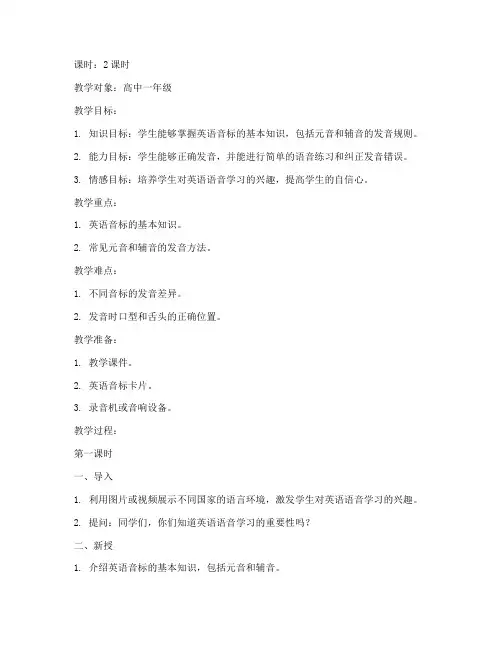
课时:2课时教学对象:高中一年级教学目标:1. 知识目标:学生能够掌握英语音标的基本知识,包括元音和辅音的发音规则。
2. 能力目标:学生能够正确发音,并能进行简单的语音练习和纠正发音错误。
3. 情感目标:培养学生对英语语音学习的兴趣,提高学生的自信心。
教学重点:1. 英语音标的基本知识。
2. 常见元音和辅音的发音方法。
教学难点:1. 不同音标的发音差异。
2. 发音时口型和舌头的正确位置。
教学准备:1. 教学课件。
2. 英语音标卡片。
3. 录音机或音响设备。
教学过程:第一课时一、导入1. 利用图片或视频展示不同国家的语言环境,激发学生对英语语音学习的兴趣。
2. 提问:同学们,你们知道英语语音学习的重要性吗?二、新授1. 介绍英语音标的基本知识,包括元音和辅音。
2. 展示音标卡片,讲解每个音标的发音方法和口型、舌头的位置。
三、语音练习1. 学生跟读,教师逐一纠正发音错误。
2. 进行简单的语音对比练习,如:/i/与/iː/,/æ/与/e/等。
四、课堂小结1. 总结本节课所学内容,强调发音技巧。
2. 布置课后作业:跟读音标卡片,练习发音。
第二课时一、复习1. 回顾上节课所学内容,提问:同学们,上节课我们学习了哪些音标?2. 学生分组进行语音对比练习,互相纠正发音错误。
二、新授1. 介绍英语语音中的连读现象,讲解连读的规则。
2. 展示连读示例,引导学生模仿发音。
三、语音练习1. 学生跟读连读示例,教师逐一纠正发音错误。
2. 进行连读练习,如:单词连读、句子连读等。
四、课堂小结1. 总结本节课所学内容,强调连读的技巧。
2. 布置课后作业:练习连读,尝试将所学连读技巧应用到实际对话中。
教学评价:1. 课堂表现:观察学生在课堂上的参与度、发音准确性等。
2. 课后作业:检查学生的语音练习情况,了解学生对所学知识的掌握程度。
备注:在教学过程中,教师应根据学生的实际情况调整教学内容和进度,注重学生的个体差异,鼓励学生积极参与课堂活动。
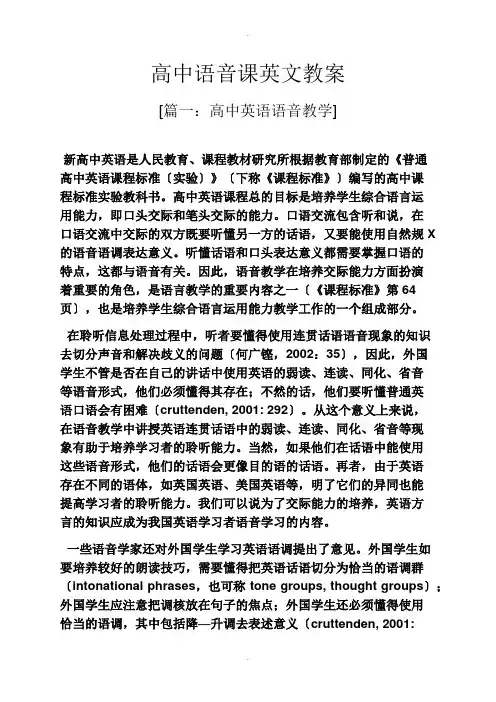
高中语音课英文教案[篇一:高中英语语音教学]新高中英语是人民教育、课程教材研究所根据教育部制定的《普通高中英语课程标准〔实验〕》〔下称《课程标准》〕编写的高中课程标准实验教科书。
高中英语课程总的目标是培养学生综合语言运用能力,即口头交际和笔头交际的能力。
口语交流包含听和说,在口语交流中交际的双方既要听懂另一方的话语,又要能使用自然规X 的语音语调表达意义。
听懂话语和口头表达意义都需要掌握口语的特点,这都与语音有关。
因此,语音教学在培养交际能力方面扮演着重要的角色,是语言教学的重要内容之一〔《课程标准》第64页〕,也是培养学生综合语言运用能力教学工作的一个组成部分。
在聆听信息处理过程中,听者要懂得使用连贯话语语音现象的知识去切分声音和解决歧义的问题〔何广铿,2002:35〕,因此,外国学生不管是否在自己的讲话中使用英语的弱读、连读、同化、省音等语音形式,他们必须懂得其存在;不然的话,他们要听懂普通英语口语会有困难〔cruttenden, 2001: 292〕。
从这个意义上来说,在语音教学中讲授英语连贯话语中的弱读、连读、同化、省音等现象有助于培养学习者的聆听能力。
当然,如果他们在话语中能使用这些语音形式,他们的话语会更像目的语的话语。
再者,由于英语存在不同的语体,如英国英语、美国英语等,明了它们的异同也能提高学习者的聆听能力。
我们可以说为了交际能力的培养,英语方言的知识应成为我国英语学习者语音学习的内容。
一些语音学家还对外国学生学习英语语调提出了意见。
外国学生如要培养较好的朗读技巧,需要懂得把英语话语切分为恰当的语调群〔intonational phrases,也可称 tone groups, thought groups〕;外国学生应注意把调核放在句子的焦点;外国学生还必须懂得使用恰当的语调,其中包括降—升调去表述意义〔cruttenden, 2001:275, 276〕。
这意味着要成功交际,外国学生在学习英语时还应注意意群〔语调群〕、停顿和语调的正确使用。
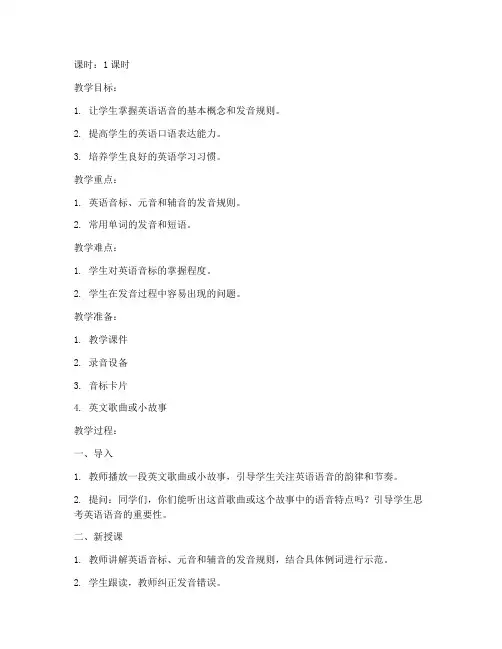
课时:1课时教学目标:1. 让学生掌握英语语音的基本概念和发音规则。
2. 提高学生的英语口语表达能力。
3. 培养学生良好的英语学习习惯。
教学重点:1. 英语音标、元音和辅音的发音规则。
2. 常用单词的发音和短语。
教学难点:1. 学生对英语音标的掌握程度。
2. 学生在发音过程中容易出现的问题。
教学准备:1. 教学课件2. 录音设备3. 音标卡片4. 英文歌曲或小故事教学过程:一、导入1. 教师播放一段英文歌曲或小故事,引导学生关注英语语音的韵律和节奏。
2. 提问:同学们,你们能听出这首歌曲或这个故事中的语音特点吗?引导学生思考英语语音的重要性。
二、新授课1. 教师讲解英语音标、元音和辅音的发音规则,结合具体例词进行示范。
2. 学生跟读,教师纠正发音错误。
3. 教师发放音标卡片,让学生通过卡片学习音标。
三、巩固练习1. 教师播放录音,学生跟读,提高发音准确度。
2. 学生分组练习,互相纠正发音错误。
3. 教师选取一些常用单词和短语,让学生进行发音比赛。
四、课堂小结1. 教师总结本节课所学内容,强调英语语音的重要性。
2. 学生分享自己在学习过程中遇到的问题,教师进行解答。
五、课后作业1. 学生回家后,复习本节课所学内容,巩固发音。
2. 每天进行英语口语练习,提高发音水平。
教学反思:1. 教师在教学过程中要注意引导学生关注英语语音的韵律和节奏,让学生在轻松愉快的氛围中学习。
2. 教师要注重纠正学生的发音错误,提高发音准确度。
3. 教师可以采用多种教学方法,如游戏、歌曲、故事等,激发学生的学习兴趣。
4. 教师要关注学生的个体差异,因材施教,让每个学生都能在英语语音学习上取得进步。
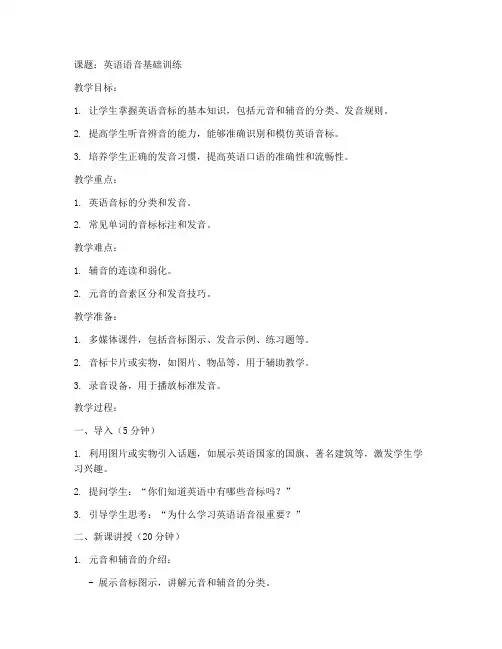
课题:英语语音基础训练教学目标:1. 让学生掌握英语音标的基本知识,包括元音和辅音的分类、发音规则。
2. 提高学生听音辨音的能力,能够准确识别和模仿英语音标。
3. 培养学生正确的发音习惯,提高英语口语的准确性和流畅性。
教学重点:1. 英语音标的分类和发音。
2. 常见单词的音标标注和发音。
教学难点:1. 辅音的连读和弱化。
2. 元音的音素区分和发音技巧。
教学准备:1. 多媒体课件,包括音标图示、发音示例、练习题等。
2. 音标卡片或实物,如图片、物品等,用于辅助教学。
3. 录音设备,用于播放标准发音。
教学过程:一、导入(5分钟)1. 利用图片或实物引入话题,如展示英语国家的国旗、著名建筑等,激发学生学习兴趣。
2. 提问学生:“你们知道英语中有哪些音标吗?”3. 引导学生思考:“为什么学习英语语音很重要?”二、新课讲授(20分钟)1. 元音和辅音的介绍:- 展示音标图示,讲解元音和辅音的分类。
- 通过PPT或板书,详细介绍每个音标的发音部位和发音方法。
- 播放标准发音录音,让学生跟读。
2. 发音规则讲解:- 讲解元音和辅音的发音规则,如元音的长短、辅音的清浊等。
- 通过举例说明,让学生理解发音规则在实际中的应用。
3. 常见单词的音标标注:- 展示一些常见单词,如“apple”、“book”等,标注音标。
- 让学生跟读,并纠正发音错误。
三、练习环节(15分钟)1. 听音辨音练习:- 播放不同音标的发音录音,让学生听音并选择正确的音标。
- 分组进行练习,提高学生听音辨音的能力。
2. 跟读练习:- 播放标准发音的单词或句子,让学生跟读。
- 教师巡回指导,纠正发音错误。
3. 发音比赛:- 组织学生进行发音比赛,激发学习兴趣。
- 设置奖项,鼓励学生积极参与。
四、总结与反馈(5分钟)1. 回顾本节课的重点内容,强调发音规则和技巧。
2. 鼓励学生在课后多练习,养成良好的发音习惯。
3. 收集学生反馈,了解学生对课程内容的掌握情况。
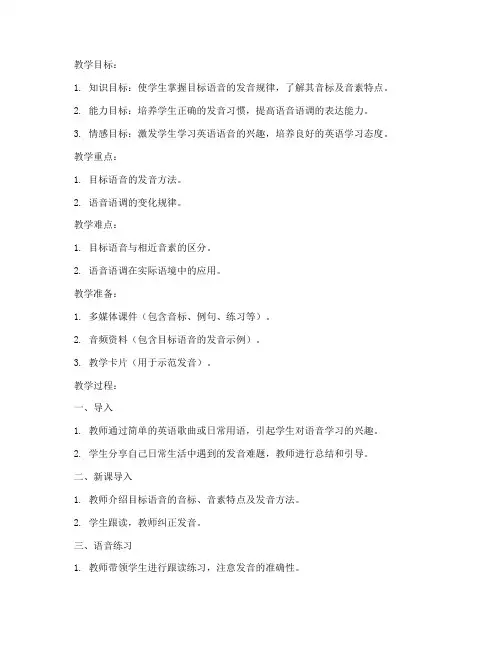
教学目标:1. 知识目标:使学生掌握目标语音的发音规律,了解其音标及音素特点。
2. 能力目标:培养学生正确的发音习惯,提高语音语调的表达能力。
3. 情感目标:激发学生学习英语语音的兴趣,培养良好的英语学习态度。
教学重点:1. 目标语音的发音方法。
2. 语音语调的变化规律。
教学难点:1. 目标语音与相近音素的区分。
2. 语音语调在实际语境中的应用。
教学准备:1. 多媒体课件(包含音标、例句、练习等)。
2. 音频资料(包含目标语音的发音示例)。
3. 教学卡片(用于示范发音)。
教学过程:一、导入1. 教师通过简单的英语歌曲或日常用语,引起学生对语音学习的兴趣。
2. 学生分享自己日常生活中遇到的发音难题,教师进行总结和引导。
二、新课导入1. 教师介绍目标语音的音标、音素特点及发音方法。
2. 学生跟读,教师纠正发音。
三、语音练习1. 教师带领学生进行跟读练习,注意发音的准确性。
2. 学生分组进行角色扮演,练习目标语音在日常语境中的应用。
四、语音语调讲解1. 教师讲解语音语调的变化规律,强调重音、连读、意群等要素。
2. 学生跟读练习,教师纠正发音和语调。
五、巩固练习1. 教师布置课后练习题,包括听写、朗读、模仿等。
2. 学生完成练习,教师检查并讲解。
六、总结1. 教师总结本节课所学内容,强调重点和难点。
2. 学生分享学习心得,提出疑问。
七、布置作业1. 完成课后练习题。
2. 复习本节课所学语音知识。
教学评价:1. 课堂参与度:观察学生在课堂上的表现,如跟读、练习、提问等。
2. 发音准确性:通过听写、朗读等方式,评估学生的发音水平。
3. 语音语调:观察学生在实际语境中运用语音语调的能力。
教学反思:1. 教师根据学生的实际情况,调整教学方法和进度。
2. 注重培养学生的发音习惯和语音语调表达能力。
3. 营造轻松愉快的课堂氛围,激发学生的学习兴趣。
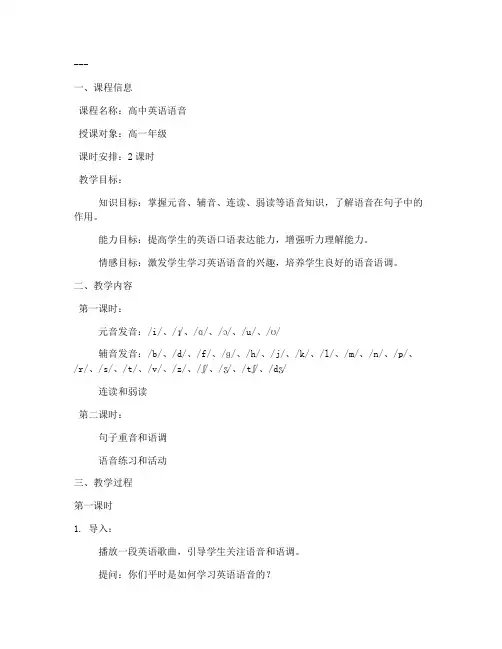
---一、课程信息课程名称:高中英语语音授课对象:高一年级课时安排:2课时教学目标:知识目标:掌握元音、辅音、连读、弱读等语音知识,了解语音在句子中的作用。
能力目标:提高学生的英语口语表达能力,增强听力理解能力。
情感目标:激发学生学习英语语音的兴趣,培养学生良好的语音语调。
二、教学内容第一课时:元音发音:/i/、/ɪ/、/ɑ/、/ɔ/、/u/、/ʊ/辅音发音:/b/、/d/、/f/、/ɡ/、/h/、/j/、/k/、/l/、/m/、/n/、/p/、/r/、/s/、/t/、/v/、/z/、/ʃ/、/ʒ/、/tʃ/、/dʒ/连读和弱读第二课时:句子重音和语调语音练习和活动三、教学过程第一课时1. 导入:播放一段英语歌曲,引导学生关注语音和语调。
提问:你们平时是如何学习英语语音的?引出本节课的主题:英语语音知识。
2. 新课讲解:元音发音:通过图片、口型示范、录音等方式,讲解元音的发音方法。
辅音发音:通过图片、口型示范、录音等方式,讲解辅音的发音方法。
连读和弱读:通过例句、录音等方式,讲解连读和弱读的规则。
3. 语音练习:学生跟读练习:跟读老师播放的录音,注意发音的准确性。
小组练习:分组进行语音练习,互相纠正发音错误。
4. 总结:回顾本节课所学内容,强调重点和难点。
布置课后作业,要求学生练习发音。
第二课时1. 复习:复习上节课所学内容,检查学生的学习情况。
2. 新课讲解:句子重音:通过例句、录音等方式,讲解句子重音的规则。
语调:通过例句、录音等方式,讲解语调的规则。
3. 语音练习:学生跟读练习:跟读老师播放的录音,注意句子重音和语调。
小组练习:分组进行语音练习,互相纠正发音错误。
4. 语音活动:语音游戏:通过游戏形式,提高学生的语音语调感知能力。
角色扮演:学生分组进行角色扮演,练习语音和语调。
5. 总结:回顾本节课所学内容,强调重点和难点。
布置课后作业,要求学生练习语音和语调。
四、教学评价课堂表现:观察学生的参与度、积极性等。
课程目标:1. 知识目标:学生能够正确识别和发音英语音标,掌握常见的语音规则。
2. 技能目标:学生能够运用所学语音知识进行单词的拼读和听力理解。
3. 情感目标:激发学生对英语学习的兴趣,培养良好的学习习惯。
教学内容:1. 单元语音知识:包括元音、辅音、连读、弱读、语调等。
2. 单词拼读技巧:如何根据音标拼读单词。
3. 听力训练:通过听力练习提高学生的语音感知能力。
教学时间:2课时教学过程:第一课时一、导入(5分钟)1. 教师播放一段英语歌曲或视频,引导学生关注歌曲或视频中的语音特点。
2. 学生分享自己对语音的感受和观察。
二、新授(30分钟)1. 介绍音标:教师展示国际音标图,讲解元音和辅音的基本发音方法。
2. 语音规则:讲解常见的语音规则,如元音的发音、辅音的发音、连读、弱读、语调等。
3. 单词拼读:通过实例演示如何根据音标拼读单词,并让学生进行练习。
三、练习(20分钟)1. 单词拼读练习:教师提供一些单词,让学生根据音标拼读出来。
2. 听力练习:播放一段听力材料,让学生根据听到的内容选择正确的答案。
四、总结(5分钟)1. 教师总结本节课的重点内容,强调音标和语音规则的重要性。
2. 学生回顾所学内容,提出疑问。
第二课时一、复习(10分钟)1. 教师提问上一节课的内容,检查学生对音标和语音规则的理解。
2. 学生回答问题,巩固所学知识。
二、巩固练习(30分钟)1. 单词拼读巩固:教师提供一些较难的单词,让学生根据音标拼读出来。
2. 听力练习:播放一段较长的听力材料,让学生完成听力任务。
三、拓展练习(20分钟)1. 语音游戏:教师组织一些语音游戏,如“音标接龙”、“发音竞赛”等,提高学生的语音感知能力。
2. 学生自由练习:学生自由组合,互相练习发音,纠正彼此的错误。
四、总结(5分钟)1. 教师对本节课进行总结,强调语音在英语学习中的重要性。
2. 学生分享自己的学习心得,提出对下一节课的期望。
教学反思:1. 教师在教学过程中要注意观察学生的学习情况,及时调整教学方法和进度。
教资高中英语语音教案【篇一:大一语音教案】教案2009 ~2010 学年第一学期系英语外事管理系教研室(组)大一年级精读组课程名称英语精读授课年级2009授课教师职称四川外语学院成都学院教务处制二○○九年八月教案(首页)教案【篇二:教师资格证高中英语面试教案写法整理】阅读课:导入(图片,问答),读前讨论预测或者听力训练,读中寻读精读标记语法点找主旨句,读后讲解语法点,小组活动teaching topic :teaching aims:1. learn some new words .2. improve students? reading ability and self-study ability.3. enable students to value/love/aware the importance of ...teaching aids: pictures, a tape recorder and ppt.teaching important points:1.improve students? reading ability.2.master the following words. teaching difficult points:1. how to make them to understand the reading text better.2. improve their reading strategy.teaching procedure: step 1:lead-inshow students? pictures on the screen. and ask them whatthey will do if they are in those situations, let them discuss inpairs and then ask some ss answer the question after 3minutes. step 2: pre- readingteacher ask the ss to listen to the record to try to grasp thegeneral idea of the passage,try to answer 2 questions.step 3: while- readingusing task-based method to help the ss improve their readingskills in this step.task1. scanning :scanning the text and find the answer of 2 questions. lookingfor the information quickly without reading the whole text.task2. detail readingread the passage carefully and do true or false exercises onthe screen. let ss get further understanding of the article andcheck their reading results.step 4: language learningfind out the new words and phrases. let them guess from thecontext.new words: newphrases: step5:summaryss summarize what we have learnt and key points. make anassessment on each group. step6: homeworkwrite a diary with simple past tense.blackboard design :title:questions: new words : 文章线索(便于复述)口语课教学过程:看图,问答练习,重点句呈现讲解,小组练习,展示成果teaching objectives:1. be able to master the following words and sentence pattern.and learn the expression of giving advice .3. improve the cooperative spirit and care more about yourselfand your family members? health. teaching aids: pictures, atape recorder and ppt.the teaching focus:1. master the following words and sentence pattern.2. master the expressions of giving advicethe teaching difficulties:1. students may find it difficult to remember all the target newwords in the class;2. students may find it difficult to give appropriate advice tothe certain disease because of their limited life experience.teaching procedure:step1 :warming upgreet ss by asking them: how are you today? then i?ll tell ssthat i?m not feeling well today (write the sentence on theblackboard and guide ss to read it.) and get ss to guess thereason freely. if ss can?t get the answer, i?ll tell them that ididn?t have a good sleep last night. so i have a headache. (isay this by doing a gesture)step2: presentation of words and sentence patterns1. let one student imitate he has a kind of disease and ask theclass guess what ?s the matter with him. use the followingsentence: ”what?s the matter with him? ”“i have a stomache. ”2. show ss pictures of diseases.( write the words on the blackboard.) step3: pair workask ss to work in pairs and talk about health problems byusing the bandage given and using the target language:what?s the matter? i?m not feeling well. i have a ⋯step4: presentation of expressions of giving advicetell ss that i have a cold/cough, ask them: what should i do?ss may give different answers, collect their answers and helpthem to use: you should/shouldn?t do ⋯during this activity, some phrases will be learned: ...step5: role play1.show the sample dialogue and ask ss to complete itaccording to the picture orally.ask students to make a four -people group, one of them is adoctor, the other three are patients. ask the ss to role play adialogue .a: what?s the matter with you?b: i?m not feeling well. i have a _______. a: when did it start?b: about______ ago.a: oh, that?s too bad. / i?m sorry to hear that. youshould/shouldn?t ________ and you should/shouldn?t________...b: yes, i think so.a: _________________.b: thank you, doctor. step5:summaryss summarize what we have learnt. make an assessment oneach group.step6: homeworktry to make a story according to the dialogue. blackboarddesign :title:new words and phrases :sentence pattern :语法课:复习导入,查找标记相关句子,总结规律,练习(造句,讨论)teaching objectives:1.enable the ss to know the uses of adjectives ending in -ing /-ed and the differences between them.2. master the following words and sentence pattern.main word and expression: amazed, amazing, interested,interesting, bored, boring.main structure: the classroom was amazing. i was completelyamazed by the classroom. teaching aids: pictures, a taperecorder and ppt.teaching important points:get the ss to know the differences between the adjectivesending in -ing and -ed and learn the uses of them in thesentences.teaching difficult points:understand the differences between the adjectives ending in –ing and –ed and apply them in the sentences .teaching procedure:step 1 lead ingreet the students and say some words which includes thelanguage points. then tell them what we are going to learn isthe differences and uses of the adjectives ending in –ing and –ed . ask students to think about the question below and try tofigure out the right answer.---can you make a distinguish between the two sentences?i am bored.i am boring .step 2 discovering and explaining.ask the students to read the text and try to find out thesentences which have the adjectives ending in -ing and –ed.try to find the differences and understand the meaning of theseadjectives.step 3 group worklet students work in groups and have a discussion. try to findthe differences of these adjectives and explain the meaning ofthese sentences according to the context.step 4 conclusion and exerciseinvite students to make a report about their group discussionand teacher will make a conclusion according to their report.find the grammar rules:1: the –ing form describes the people or things that cause thefeeling; (令人?)2: the –ed form tells us how people feel. (感到?)give some examples to show what they have learned and ask students to do exercise andcheck the answers. fill in the blank with the correct forms of words.it is a ____ (bore)party and i feel__(bore). step 5 homework1. find out more adjectives ending in -ing and -ed and sentences.e the -ed and - ing form of the words “bore ”“interest ” “amaze”and “embarrass ”to make sentences.blackboard design :title:words and phrases : sentencepattern :.听力课:导入,听主要内容检查主要内容,听细节(给问题),分角色,对话表演写作课:复习导入,展示讨论图片,描述内容/文体,总结关键词语,教师指导,写作文【篇三:教师资格证英文教案】teaching plantype: module lesson material: threedays to seeteaching aids: multi-media and blackboardinstructor: zhu yunclass: class 12, senior ii, jianping high schoolteaching objectives:language objectives:1. to build up students ’vocabulary by reading and analyzing famous writings;2. to train students to further develop their reading skills.emotional objectives:1. to cultivate students ’appreci a ti o onf the masterpiece;2. to arouse students ’awareness of the beauty of nature;3. to get students to learn to cherish people and things around.ability objectives:1. to develop students ’ability to guess meanings of words through the context;2. to cultivate students ’spirit of cooperation with classmates.teaching proceduresi. presentation: pre-reading1. test students ’awareness of the change of things around;2. give a brief introduction of helen keller.ii. practice: while-readingi) read and understand the first two paragraphs1. did helen keller think it was good or bad if people werestricken blind and deaf for a fewdays at some time during his early adult life?2. how do you know that? (which word tells you?)3. why did helen think it was a good idea for people to losetheir ability of sight and hearing?4. did one of helen ’s friends observe anything when she returned from a long walk inthewoods?5. what did she say in reply to helen ’s question?6. was her friend also blind (or was she normal)?7. which word tells you that?8. what did she say about the seeing people?9. how do you understand the sentence “the seeing see little ”?do you agree? why?10. how did helen feel when saying “how was it possible ”? then how did helen feel the beauty of nature?ii) read and appreciate the third paragraph。
高中英语语音课的教学设计一、教学任务及对象1、教学任务本教学设计针对的是高中英语语音课,旨在帮助学生掌握英语语音基础知识,提高学生的英语发音准确性,培养良好的语音语调感知能力和模仿能力。
通过本课程的学习,学生将能够正确拼读单词,流利朗读句子,掌握基本的语音规则,形成良好的语音习惯,从而为日后的英语听、说、读、写技能的提升打下坚实基础。
2、教学对象本教学设计的教学对象为高中一年级学生,他们已经具备了一定的英语基础,掌握了基本的词汇和语法知识,但对英语语音知识了解不多,发音准确性有待提高。
此外,这个年龄段的学生具有较强的模仿能力和学习兴趣,但注意力容易分散,需要教师采用丰富多样的教学手段和方法,激发学生的学习兴趣和积极性。
二、教学目标1、知识与技能(1)理解并掌握英语语音基础知识,如音标、音素、重音、连读等;(2)学会正确拼读单词,提高发音准确性;(3)能够流利朗读句子,掌握基本的语音规则;(4)培养良好的语音语调感知能力和模仿能力;(5)提高英语听力水平,为日后的英语学习奠定基础。
2、过程与方法(1)通过课堂讲解、示范、模仿等环节,让学生掌握语音知识;(2)采用任务型教学法,让学生在完成具体任务的过程中,锻炼语音技能;(3)运用多媒体教学手段,如视频、音频等,丰富教学内容,提高学生的学习兴趣;(4)组织小组讨论、角色扮演等活动,培养学生的合作精神和口语表达能力;(5)鼓励学生课后自主练习,形成良好的学习习惯。
3、情感,态度与价值观(1)激发学生对英语语音学习的兴趣,树立自信心;(2)培养学生勇于尝试、不怕犯错的精神,增强自主学习能力;(3)引导学生正确认识英语语音学习的重要性,提高学习积极性;(4)通过学习英语语音,拓展学生的国际视野,培养跨文化交际意识;(5)教育学生尊重他人,团结协作,形成积极向上的人生态度。
三、教学策略1、以退为进在教学过程中,教师采取“以退为进”的策略,即在传授语音知识时,先从学生已经掌握的知识点出发,逐步引导学生接触新知识。
一、教材分析本节课选用自人教版高中英语教材,以语音知识为核心,旨在帮助学生掌握英语语音的基本规律,提高英语口语发音的准确性和流畅性。
二、教学目标1. 知识目标:- 学生能够掌握英语元音、辅音的基本发音规则。
- 学生能够识别和区分不同音素的发音。
- 学生能够理解并运用连读、弱读等语音现象。
2. 能力目标:- 学生能够运用所学语音知识进行日常口语交流。
- 学生能够通过模仿和练习提高英语口语发音的准确性和流畅性。
3. 情感目标:- 学生能够对英语语音学习产生兴趣,增强学习英语的自信心。
- 学生能够在学习过程中培养良好的学习习惯和团队合作精神。
三、教学重难点1. 重点:- 英语元音、辅音的发音规则。
- 连读、弱读等语音现象的运用。
2. 难点:- 英语元音、辅音发音的准确性。
- 语音现象在实际口语中的应用。
四、教学方法1. 讲授法:教师讲解语音知识,引导学生理解和掌握。
2. 演示法:教师示范发音,帮助学生直观地感受发音方法。
3. 练习法:通过大量的练习,帮助学生巩固所学知识。
4. 合作学习法:小组讨论和合作练习,提高学生的口语表达能力。
五、教学工具1. 多媒体课件2. 音响设备3. 英语教材4. 练习题六、教学过程1. 导入(5分钟)- 教师通过播放英语歌曲或视频,激发学生的学习兴趣。
- 提问:同学们,你们平时在学习英语的过程中,有没有遇到发音上的困难?2. 新课讲授(20分钟)- 教师讲解英语元音、辅音的发音规则,结合图片和视频进行示范。
- 引导学生识别和区分不同音素的发音。
- 讲解连读、弱读等语音现象,并举例说明。
3. 练习环节(15分钟)- 学生跟读练习,教师巡回指导。
- 小组合作练习,互相纠正发音。
- 游戏环节,如“谁是最佳发音王”,提高学生的参与度。
4. 总结与反思(5分钟)- 教师总结本节课的重点内容,强调发音的重要性。
- 学生分享学习心得,提出自己在发音上遇到的问题。
七、板书设计1. 英语元音、辅音发音规则2. 连读、弱读现象3. 发音练习方法八、教学评价与反思1. 评价方式:- 课堂参与度- 发音准确性- 口语表达能力2. 教学反思:- 不断优化教学方法,提高教学效果。
英语语音教学的教案一、教学内容本节课的教学内容选自人教版高中英语教材,第三章第二节,主要内容包括元音和辅音的发音规则,以及单词的重音和句子的节奏。
二、教学目标1. 学生能够掌握元音和辅音的发音规则,正确拼读单词。
2. 学生能够理解单词的重音和句子的节奏,流利地朗读英语。
3. 学生能够运用所学的发音规则和朗读技巧,提高英语口语表达能力。
三、教学难点与重点重点:元音和辅音的发音规则,单词的重音和句子的节奏。
难点:单词的重音和句子的节奏的运用。
四、教具与学具准备教具:多媒体课件、黑板、粉笔。
学具:教材、笔记本、录音机。
五、教学过程1. 实践情景引入:教师播放一段英语对话,引导学生注意说话人的语音和语调。
2. 讲解发音规则:教师利用多媒体课件,讲解元音和辅音的发音规则,并通过例词进行讲解。
3. 示范与练习:教师示范发音,学生跟读,并进行分组练习,相互纠正发音。
4. 讲解单词重音:教师通过例词讲解单词的重音,学生跟读,并进行练习。
5. 讲解句子节奏:教师通过例句讲解句子的节奏,学生跟读,并进行练习。
7. 作业布置:学生回家后,听录音,跟读课文,并练习发音规则和朗读技巧。
六、板书设计板书内容:1. 元音发音规则2. 辅音发音规则3. 单词重音4. 句子节奏七、作业设计1. 听录音,跟读课文,熟记元音和辅音的发音规则。
2. 练习单词的重音和句子的节奏,提高朗读能力。
八、课后反思及拓展延伸课后反思:1. 学生对元音和辅音的发音规则掌握情况如何?2. 学生对单词的重音和句子的节奏的理解和运用情况如何?3. 针对学生的掌握情况,如何调整教学方法和策略?拓展延伸:1. 引导学生关注英语语音的变化和发展,了解不同的英语口音。
2. 组织英语角活动,让学生有机会运用所学的发音规则和朗读技巧,提高口语表达能力。
3. 推荐学生参加英语演讲比赛、英语剧社等活动,锻炼英语表达能力。
重点和难点解析一、教学内容本节课的教学内容选自人教版高中英语教材,第三章第二节,主要内容包括元音和辅音的发音规则,以及单词的重音和句子的节奏。
高中英语语音讲解教案模板一、教学目标1.让学生掌握英语音标,了解发音规则;2.培养学生正确的发音习惯,提高口语表达能力;3.使学生能够运用所学语音知识,进行有效听力理解。
二、教学重点1.英语音标及发音规则;2.发音器官的正确使用;3.听力训练。
三、教学难点1.辅音字母组合的发音;2.元音字母组合的发音;3.连读、弱读、同化等语音现象。
四、教学准备1.PPT课件;2.音标卡片;3.发音示范视频;4.听力练习材料。
五、教学过程1.导入(1)向学生介绍英语音标的重要性和实用性;(2)激发学生的学习兴趣,让他们认识到学习音标对提高英语水平的帮助。
2.基本概念讲解(1)介绍音标的概念及分类;(2)讲解音标的书写规则;(3)演示音标的发音方法。
3.发音规则讲解(1)讲解元音字母的发音规则;(2)讲解辅音字母的发音规则;(3)讲解字母组合的发音规则。
4.发音练习(1)分组进行音标发音练习;(2)教师逐一纠正发音错误;(3)学生自主练习,巩固发音。
5.听力训练(1)播放听力材料,让学生听懂大意;(2)分析听力材料中的语音现象;(3)让学生模仿听力材料中的发音,提高听力理解能力。
6.互动环节(1)学生自由发挥,用所学音标进行交流;(2)教师点评,给出建议;7.课堂小结(1)回顾本节课所学内容;(2)强调音标的重要性;(3)布置课后作业。
六、课后作业1.复习本节课所学的音标及发音规则;2.自主进行发音练习,提高发音水平;3.完成听力练习,提高听力理解能力。
七、教学反思1.本节课的教学效果如何,有哪些不足之处;2.学生对音标的掌握程度,如何进一步提高;3.如何激发学生的学习兴趣,让他们主动参与课堂。
通过本节课的学习,学生应能够掌握基本的英语音标及发音规则,具备一定的发音能力。
教师应根据学生的实际情况,调整教学策略,提高教学效果。
同时,教师要关注学生的学习兴趣,让他们在愉快的氛围中学习英语。
重难点补充:一、教学重点补充1.英语音标及发音规则:利用PPT展示音标表,同时播放每个音标的发音示范;引导学生通过跟读、模仿来熟悉音标发音;设计小测验,让学生辨别并拼写出所听到的音标。
高中语音课英文教案【篇一:高中英语语音教学】新高中英语是人民教育出版社、课程教材研究所根据教育部制定的《普通高中英语课程标准(实验)》(下称《课程标准》)编写的高中课程标准实验教科书。
高中英语课程总的目标是培养学生综合语言运用能力,即口头交际和笔头交际的能力。
口语交流包含听和说,在口语交流中交际的双方既要听懂另一方的话语,又要能使用自然规范的语音语调表达意义。
听懂话语和口头表达意义都需要掌握口语的特点,这都与语音有关。
因此,语音教学在培养交际能力方面扮演着重要的角色,是语言教学的重要内容之一(《课程标准》第64页),也是培养学生综合语言运用能力教学工作的一个组成部分。
在聆听信息处理过程中,听者要懂得使用连贯话语语音现象的知识去切分声音和解决歧义的问题(何广铿,2002:35),因此,外国学生不管是否在自己的讲话中使用英语的弱读、连读、同化、省音等语音形式,他们必须懂得其存在;不然的话,他们要听懂普通英语口语会有困难(cruttenden, 2001: 292)。
从这个意义上来说,在语音教学中讲授英语连贯话语中的弱读、连读、同化、省音等现象有助于培养学习者的聆听能力。
当然,如果他们在话语中能使用这些语音形式,他们的话语会更像目的语的话语。
再者,由于英语存在不同的语体,如英国英语、美国英语等,明了它们的异同也能提高学习者的聆听能力。
我们可以说为了交际能力的培养,英语方言的知识应成为我国英语学习者语音学习的内容。
一些语音学家还对外国学生学习英语语调提出了意见。
外国学生如要培养较好的朗读技巧,需要懂得把英语话语切分为恰当的语调群(intonational phrases,也可称 tone groups, thought groups);外国学生应注意把调核放在句子的焦点;外国学生还必须懂得使用恰当的语调,其中包括降—升调去表述意义(cruttenden, 2001: 275, 276)。
这意味着要成功交际,外国学生在学习英语时还应注意意群(语调群)、停顿和语调的正确使用。
对学习者来说,这是在说方面的要求。
根据上面的论述并结合《课程标准》语音项目表的内容,高中英语课程语音教与学的内容可以综合概括如下:一、教学内容通过英语语音教与学,学生 1. 进一步巩固基本读音能力,即能按读音规则读出新单词的音;2. 明了操英语为本族语的人士如何在连贯话语中使用连读、弱读、同化、不完全爆破、停顿和不同的语调等进行口语交流;3. 掌握英语元、辅音的发音,连贯话语中重音、连读、弱读、不完全爆破、停顿和语调的使用;4. 在基本掌握英语口音(这里指 received pronunciation 下称 rp)的基础上,接触美国口音(这里指general american下称 ga),为顺利进行交际打下基础;5. 掌握朗诵和演讲的语音技巧。
上面五个方面的教学内容可以具体描述如下:1. 基本读音能力包括掌握(1)元音字母和元音字母组合在重读音节的读音,如 role, polite, cheat 等。
(2)元音字母和常见元音字母组合在轻读音节的读音,如 finally, position, valley 等。
(3)辅音字母及辅音连缀的读音,如 judge, stage, include 等。
2 明了操本族语的英语人士在连贯话语中使用不同的语音手段进行交流。
这些语音手段包括:(1)连读①两单词同属一意群时,前一单词以辅音结尾,而后一单词以元音开头,结尾的辅音与开头的元音连读(celce-murcia, 2001(ed): 121,122;celce-murcia, et al, 1996: 158, 159)。
如:lisa wrote a letter︶all of them︶②两单词同属一意群时,前一单词以 r 或 re 结尾,后一单词以元音开头,这时原不发音的字母 r 发/r/,与后开头的元音连读(cruttenden, 2001: 288, 289)。
如:for a meeting︶here is a letter.︶(2)弱读①明了//是非重读音节出现最普遍的元音,也是语篇中频率出现最高的元音(cruttenden, 2001: 148)。
②掌握最常用的功能词的弱读形式(cruttenden, 2001: 252, 253;roach, 1991: 103-108)。
● the: 弱读形式在辅音前读/h/,在元音前读/h/● a, an: 弱读形式在辅音前读//,在元音前读/n/● and: 弱读形式/n/和/nd/● but: 弱读形式/bt/● that: 弱读形式在引出从句时读/ht/,作指示代词用强式读音/h#t/● than: 弱读形式/hn/● his: 弱读形式/z/,但在句子开头和作物主代词读/hz/● her: 弱读形式在辅音前读//,在元音前读/r/;在句首读/h/● your: 弱读形式在辅音前读/j/,在元音前读/jr/● he: 弱读形式//,在句首读/h/● him: 弱读形式/m/● them: 弱读形式/hm/● us: 弱读形式/s/● at: 弱读形式/t/, 在句末读/#t/● for: 弱读形式在辅音前读/f/,在元音前读/fr/;在句末读/f:/● from: 弱读形式/frm/, 在句末读/frm/● of: 弱读形式/v/,在句末读/v/● to: 弱读形式在辅音前读/t/,在元音前读/tu/;在句末读/tu/● as: 弱读形式/z/, 在句末读/#z/● some: 弱读形式作“一些”解时读/sm/,作“某一”解和在句末时读/sm/● there: 作引导词,弱读形式在辅音前读/h/,在元音前读/hr/;在句末和作指示代词读/he/● can, could: 弱读形式分别读/kn,kd/,在句末分别读/k#n/和/kud/● have, has, had: 弱读形式分别读/v, z, d/,在句末分别读/h#v,h#z, h#d/;have 在 i, we, you,they 后读/v/;had 在 i, he, she, we, you, they 后读/d/● shall, should: 弱读形式分别读/.l, .d/;在句末分别读/.#l, .ud/● must: 作“必须”解时,弱读形式在辅音前读/ms/,在元音前时读/mst/;在句末读/mst/;作推测意为“必定”时读/mst/● do:作助动词时,弱读形式在辅音前读/d/,在元音前读/du/,在句末读/du:/● does: 弱读形式/dz/, 在句末读/dz/● am:弱读形式在 i 后读/m/,在其他地方读/m/;在句末读/#m/● are: 弱读形式在辅音前读//,在元音前读/r/,在句末读//● was: 弱读形式/wz/, 在句末读/wz/(3)同化①顺同化:前面的一个音影响后一个音,使后面的音变得跟它相似。
例如:whats (/′wts/) on the desk?②逆同化:后面一个音倒过来影响前面一个音,使前面的音变得与它相似。
例如:this shop (/h. .p/)③相互同化:两个连在一起的音念起来不太方便,于是就互相影响,混合成为一个新的、折衷的比较好念的音。
例如:would you(/′wud9/)like to become famous?(4)意群与停顿在自然的语篇中,人们使用停顿把言语分成便于处理的一块块,这些分割成的部分称意群(thought groups, tone groups or intonational phrases)。
意群经常是一个有意义的语法单位,与句子或分句相对应。
例如新高中英语模块一第三单元阅读短文前几句可以由停顿(用/表示)分为若干意群。
my name is wang kun./ since middle school,/ my sister wang wei and i / have dreamed about taking a great bike trip./ whenwe graduated from college,/ we finally got the chance to do it /...(5)语调①掌握三种常用的调型,即升调、降调和降—升调。
除升、降调外,在英语中降—升调是一种出现频率很高的调型(cruttenden, 2001: 276, o’connor, 1976: 150)。
3. 掌握英国英语(rp)和美国英语(ga)之间的主要区别。
课文单词注 rp 的发音,教学拟以 rp 为教学口音,介绍 ga 的目的是让学生了解不同口音的特点,在聆听理解中不会出现理解障碍。
(1)元音差异①当字母a 出现在辅音/f,g,s/或在“鼻音+辅音”前时,在rp 念//,在 ga 念/#/。
例如:单词 rp gabath /bg/ /b#g/ask/sk/ /#sk/dance /dns//d#ns/②当字母 o 在词中念 rp //时,在ga念//。
例如:单词rpgablock/blk/ /blk/quality /′kwlt//′kwlt/但在 /g, 0, s, f,g/前,上述字母 o 虽在 rp 念//,但在 ga 不念//,而念//的长音。
听起来//的长音与 rp/:/相似。
③在某些单词中 rp 和 ga 使用不同元音。
例如:单词 rp gaclerk /klk//kl9:rk/ate /et/ /et/either /′h//′i:hr/tomato /t′mt/ /t′mt/record /′rek:d/ /′rek9:rd/(2)辅音差异①在 ga 中字母 r 在所有位置,即词首、词尾、元音前、元音后,都发卷舌音。
该 /r/音【篇二:英语语音教案】《英语语音》课程教学教案unit 1unit 2unit 3unit 4unit 5unit 6unit 7unit8phoneme and transcription the pure vowels the diphthongs rules of reading of english vowel letters the consonants connected speech (1) connected speech (2) connected speech (3)unit 1 phoneme and transcriptionpurpose:the students will learn some basic concepts in english pronunciation. we are going to learn something about syllables, stress and rhythm in english. at the same time, they will learnto say greetings and farewell with appropriate pronunciation and intonation in english.objectives: students will be able to :1. define - in their own words a definition for “syllable” and “stressedsyllable”, then a definition for “rhythm” and “rhythmic pattern”;2. compare – based on the understanding of the basic concept, compare thedegrees of stress and different rhythmic patterns;3. practice – imitate the typical stress patterns and rhythmic patterns inenglish.activities and procedures:1. begin by asking the class to find out how much thestudents know about stress patterns and rhythmic patters in english, make sure that it serves the purpose of stimulating the students to think about the issue and have the desire to find out the answers themselves.2. display examples by playing the recording of the native speakers showing the typical stress patters and rhythmic patterns in english.3. ask the students to listen to the tapes to mark out the stressed syllables in words.4. ask the students to listen to the tapes to mark out the stressed words in sentences.5. have the students imitate the stress patterns and rhythmic patterns to experience the rhythm in speech.6. have the students share what they have learned by reading out the practice materials in pairs.7. have the students listen to the conversations recorded by native speakers of english and try to get the rhythmic patterns in their speech.8. have the students practice the guided conversation. ask them to pay special attention to the stress the rhythm in speech.9. highlight the language function in the conversation in the practice.10. have several pairs of the students present their conversation in the class.11. comment on the students? performance by highlightingthe achievement of the students and the efforts they need for the improvement.12. ask the students to do more practice after class and get ready for presentation during the next session.basic concepts: syllables, stress rhythmin this unit, we are going to learn some basic concepts in english pronunciation. we are going to learn something about syllables, stress and rhythm in english. at thesame time, we are going to learn to say greetings and farewell with appropriate pronunciation and intonation in english.first of all, let?s look at the syllable in english.please listen to the following word: driveway.now, tell me, how many syllables there are in this word? right. there are two. please listen to the following sentence: drive him away.tell me, how many syllables there are in this sentence? right. there are four.introductionso. what is a syllable?a syllable is a word part and the basic unit of english rhythm. english words can have one, two, three or even more syllables. in the word ?driveway?, there are two syllables. in the sentence ?drive him away?, there are four.what is a stressed syllable?in english words with more than one syllable, one of them will receive more stress than the others. stressed syllables are those that are marked in the dictionary as stressed. for example, in the word ?driveway?, the first syllable is a stressed syllable while the second syllable is not.stressed syllables in english are usually longer, louder, and higher in pitch. listen to the following example:syllable 1 syllable 2 (short) (long)syllable 3(short)the word banana has 3 syllables. syllable 1 is not stressed and so is short. syllable 2 is stressed and so is long with a clear vowel sound / :/. syllable 3 is not stressed and so is also short. here is a short summary about the stressed and unstressed syllables:stressed syllables are strong syllables. unstressed syllables are weak syllables. stressed syllables:- are long- have a pitch change- have full vowel sounds.unstressed syllables:- are short- often have a reduced vowel sound.now let?s look at the rhythm in english.we all know that correct pronunciation of the individualenglish sounds is important in communication. the way the sounds are organized, however, is often more crucial for understanding. the rhythm of english, for example, is one ofthe two major organizing structures that native speakers relyon to process speech.what is rhythm?rhythm can be found everywhere in life: the sound of a clock, the beating of the heart, the strokes of a swimmer, and of course in poetry and music. but rhythm in language is less familiar because it is less obvious. the rhythm of a language is characterized by the timing pattern of successive syllables. in some languages, every syllable is given about the same length, while in others, syllables vary in length. in english, strongbeats are called stress -- the heart of the rhythmic pattern.音节、重音与节奏本单元将向大家介绍英语语音语调的基本概念, 主要介绍英语语音的音节、重音和节奏规律。